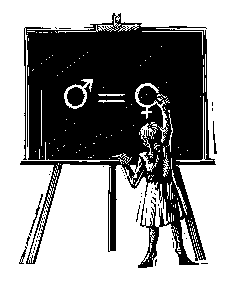|
|
|
|

Women and girls: education, not discrimination
A better world for all: empowering women and eliminating gender disparities in primary and secondary education by 2005 as an international development goal
by Giovanna Prennushi, Poverty Group, Poverty Reduction and Economic Network, World Bank, Stephen Browne, Senior Poverty Adviser, United Nations Development Programme

Picture a country where girls are not allowed to go to school just because they are girls and must work instead. Or where sick babies die because their mothers cannot read the prescription on the medicine bottle. Imagine a society where parents remove their daughters from school at puberty, for fear of unwanted pregnancy, and marry them off early to husbands their daughters do not necessarily want.
Such is the plight of girls in many developing countries: they continue to be systematically more disadvantaged than boys solely because of discrimination by gender. Some 60% of the 10 million children not in school in developing nations are girls. The gender gap continues to be unacceptably wide despite the fact that the education of girls and women is now on policymaking agendas in most developing nations and the fact that 44 million more girls attend primary schools in developing countries than in 1990.
Education can make all the difference to a girl's life, not just economically, but for her human development too. And as Kofi Annan, secretary-general of the UN says, it is a social development policy that works, with immediate benefits for family planning, nutrition, health and, economic productivity as well as social and political participation. The UN has announced a ten-year Girls' Education Initiative at the recent World Education Forum in Dakar in April 2000. The objective is to get the main countries affected to come up with national action plans by next year that promote gender equality and sensitivity in all aspects of education. The initiative will help countries free up funds for girls' schooling by helping them to get the most from development cooperation, policy and education reform. The hope is that by 2015, all children everywhere - boys and girls alike - will be able to complete primary schooling education; and to ensure that by then boys and girls will have equal access to all levels of education.
More and more governments now realise the importance of striking a balance in meeting the needs of girls' and boys' education. The Egyptian government is integrating a successful concept of girl-friendly community schools - by using female teachers, active learning and child-centred class management - into the formal education system. In Mashan County in China, villages and households that take effective measures to send girls to school are awarded priority for loans or development funds. And a promising initiative in Tanzania aims to help girls speak out about their problems and find solutions to overcome obstacles to their own social and academic development. In other countries, older girls mentor younger girls and coach them during the holidays in mathematics and science.
But education problems affect boys too. Sometimes boys are pulled out of school and sent out to work to boost family income. In Jamaica boys' drop-out rate is higher than for girls. The government is investigating effective measures for reducing this distortion.
Trading Places
Still, overall there is a gender gap and African and South Asian countries especially have a long way to go to close it. An average six-year-old girl in South Asia can expect to spend six years in school - three years less than a boy of the same age. Girls based in a rural area lose out even more, since they run three times the risk of dropping out of school than a city boy. Discrimination is reinforced in the classroom, as research shows that both male and female teachers tend to give more attention to boys, a trend now being tackled by gender-sensitive training programmes.
Traditional beliefs and practices are often at the root of the gender gap, keeping girls at home to supplement family welfare by working and caring for siblings and the household. The weight of these beliefs and a shortage of alternative opportunities to supplement household income and welfare often cause parents to distrust the education system or to feel they have no choice.
There is an old saying that an intelligent family has an intelligent mother. Certainly, studies suggest that girls with literate mothers are more likely to go to school than girls without. UNESCO underlines the necessity of reaching both girls and their mothers in the same initiative. It is a dual approach which has reaped rewards in rural Mali, where an imaginative community-based campaign using riddles, rhymes and the radio changed long-held attitudes to girls and women. And once the village women were involved in literacy and income-generating activities, they too supported the movement to educate girls.
These are small anecdotes of success, perhaps. But they show that while education may be a powerful tool, it is the simple lessons, in human dignity and mutual respect, that work best in the end.